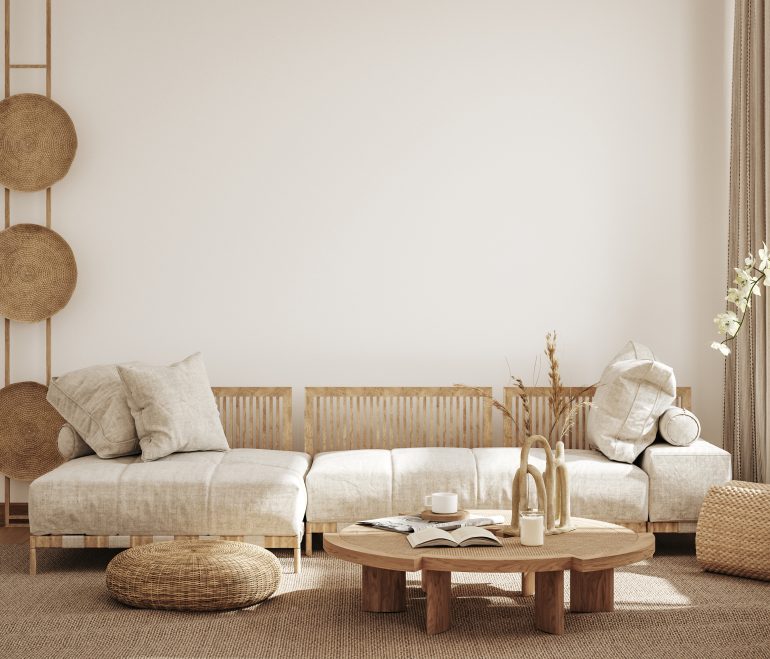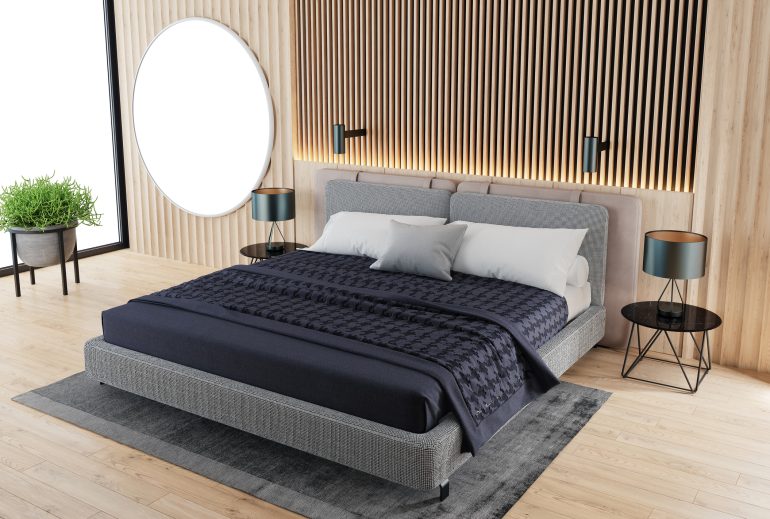What is Japandi home decor? A portmanteau of ‘Japanese’ and ‘Scandinavian’, Japandi design emphasises clean lines, organic elements inspired by the natural world, light spaces, and muted hues to create serene and inviting living environments. It’s an effortless fusion of Scandinavian functionality and elegant minimalism from Japan. In this article, we’ll answer the question: What is Japandi style?
As design trends come and go, the rise of Japandi design speaks to the pursuit of a balanced life. In this guide, we’ll delve into this design phenomenon, unveiling the nuances that make Japandi decor not just a transient fad, but a reflection of timeless principles from two distinct cultures.
So, whether you’re redesigning a family home or just looking to bring a touch of style to an urban apartment, understanding the essence of Japandi interior design is the key to creating an inviting, warm, and timeless space.
Japandi Design: Wabi-Sabi & Hygge

Japandi Style Living Room Interior With Sofa, Armchair, Coffee Table And Houseplants. (Credit: onurdongel via Getty Images)
Central to Japandi decor are key elements that breathe life into its core philosophy. From the Japanese side, it incorporates the ancient principle of wabi-sabi — the art of finding beauty in transience and imperfection. It embraces the natural wear and tear of objects, appreciating the subtle irregularities, the weathered textures, and the organic decay over time. Wabi-sabi promotes a deep connection to the natural world and values simplicity and authenticity.
In tandem with wabi-sabi is hygge. A Danish concept, hygge encapsulates the essence of cosiness, comfort, and contentment in life’s simple pleasures. It’s the warm ambiance of candle-lit rooms, the joy of putting on a big snuggly jumper, the intimacy of gatherings with loved ones, or the solace in a steaming mug of hot chocolate on a winter’s day. More than just a design principle, hygge is a lifestyle approach that cherishes moments of well-being, conviviality, and a deep sense of satisfaction in the everyday. So, what is Japandi home decor?
Japandi Furniture: Style and Sophistication

Japandi style living space (Credit: tulcarion via Getty Images)
The hallmark of Japandi interior design, especially where furniture is concerned, lies in its harmonious fusion of colours and materials, bringing together the best of Japanese and Scandinavian aesthetics.
Predominantly featuring a neutral colour palette of soft whites, greys, and earthy browns, the atmosphere is occasionally punctuated with muted natural hues like greens or blues. This sense of tranquillity is further accentuated by the extensive use of natural materials. Wood, both light (ash or pine) and dark (walnut or oak), stands out, while other elements like rattan, bamboo, stone, and clay underscore the style’s connection to nature.
The philosophy of Japandi design champions simplicity and functionality. The furniture, characterised by clean lines – straight or gently curved – dispenses with unnecessary embellishments, melding Japanese precision with Scandinavian practicality. This minimalism ensures that each piece is not just visually pleasing but also serves a distinct purpose. Often, pieces are low-slung, drawing inspiration from traditional Japanese furniture’s closeness to the ground.
Attention to detail remains a cornerstone of Japandi decor. Joinery techniques, often laid bare, transform into design statements. Furthermore, the tactile experience is key, with finishes often chosen to accentuate the natural roughness of wood or the gentle weave of fabric. Japandi furniture represents a quiet luxury, where understated elegance coexists with functional cosiness, creating spaces that resonate with nature.
The Calming Colours of Japandi Interior Design

Modern Japandi conceptual apartment interior livingroom, exhibiting the calming colours of Japandi interior design. (Credit: Victoriia Kovalchuk via Getty Images)
When we ask ‘what is Japandi design’, at its heart lies a carefully curated colour palette designed to evoke a profound sense of calm and harmony. Both Japanese and Scandinavian influences converge to champion spaces that serve as tranquil havens amidst the bustle of modern life.
For walls, the Japandi aesthetic favours neutral, muted tones. Soft whites and off-whites often serve as base colours that subtly welcomes natural light. Variations of pale greys and gentle beiges might also be introduced, adding depth without overwhelming the senses. Occasionally, to introduce contrast or a focal point, deeper hues like charcoal or indigo might be applied, but always with a restrained hand, ensuring the overarching ambiance isn’t disrupted.
When it comes to linens, the emphasis remains on natural, understated elegance. Earthy tones, like oatmeal, taupe, or muted greens, are popular choices, and they often sport simple textures that echo the beauty of raw, organic materials. The fabric itself tends to lean towards the natural – think pure cotton, linen, or bamboo – adding to the sensory experience of comfort and connection with nature.
The palette of calming colours in Japandi design extends to soft furnishings like throws, pillows, curtains, or rugs. Muted pastels like soft moss, faded terracotta, or washed-out blues, often make an appearance. However, it’s essential to maintain balance. In Japandi decor, less is more, ensuring each piece and its colour is purposefully chosen to contribute to the room’s harmonious symphony rather than dominate it.
Japandi interior design is a delicate dance of restraint and expression. Every hue and shade is thoughtfully selected with the primary aim of weaving together a space that radiates calm, harmonious energy.
How to bring Japandi Design in to your Home

Home interior in Japandi style. (Credit: Artjafara via Getty Images)
Delving into the Japandi interior design trend begins with embracing minimalism. A foundational step is decluttering, resonating with the Japandi ethos of simplicity and the Japanese concept of ma, which refers to negative space or the space between things. Once that’s achieved, the balance between the Scandinavian and Japanese influences becomes a personal choice.
Dutch Japandi design expert Laila Rietbergen says, “Your space can lean more towards the clean lines of Scandinavian design or the deeper hues and materials emblematic of Japanese aesthetics.” This might mean opting for a darker palette, enriched with stones and dark woods for a Japanese touch, or lightening things up to capture the airy feel of Scandinavian designs.
Echoing a similar sentiment, Indonesia-born interior designer Shanty Wijaya emphasises the seamless blending of indoor and outdoor spaces. This can manifest in the form of expansive windows, sunrooms, patios, or even the strategic placement of plants. And to infuse the comforting charm of Scandinavian ‘hygge’, Wijaya suggests cultivating warmth and cosiness. “Imagine a fireplace anchoring your living room, the soft glow of candles, or plush blankets inviting relaxed evenings with loved ones — it’s about crafting an environment that radiates togetherness and comfort.“
Embracing the Tranquillity of Japandi Design

Modern and japandi-style bedroom with light wooden materials. (Credit: tulcarion via Getty Images)
In the ever-evolving landscape of interior design, Japandi decor stands out as a testament to the timeless appeal of simplicity, functionality, and deep-rooted connection to nature.
Seamlessly marrying Japanese elegance with Scandinavian functionality, this style goes beyond mere aesthetics – it’s a lifestyle, a philosophy, a way to carve out tranquillity in our often chaotic lives.
Whether you’re leaning towards the dark, rich tones reminiscent of traditional Japanese interiors or the airy, minimalistic vibe of Scandinavian homes, Japandi interior design offers a versatile palette to craft spaces that resonate with serenity and purpose. As design trends come and go, the essence of Japandi remains – a pursuit of balance, harmony, and mindful living.








